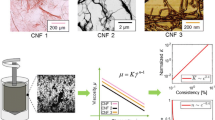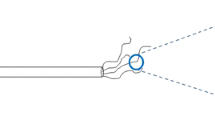Abstract
Cellulose nanofibrils (CNF) from wood fibers are of increasing interest to industry because they are from renewable sources and are biodegradable. Owing to their high aspect ratio, they produce viscous suspensions and stiff gels that are strengthened by interfibrillar hydrogen bonds. In this study, the viscosity of aqueous CNF suspensions, at dilute concentrations (\(nL^{3}<1\)), was measured at various pH values by addition of HCl, and at various ionic strengths by addition of NaCl and \(\hbox {CaCl}_{2}\). The results show that the primary electroviscous effect significantly increases the intrinsic viscosity. The intrinsic viscosity under conditions where the surface charge of nanofibrils is fully screened is in good agreement with the predictions of classical theory for dispersions of rodlike particles at low shear rates. Increasing the ionic strength up to \(\kappa d\approx 1\) decreases the intrinsic viscosity; at \(\kappa d>1\), the intrinsic viscosity increases because of fibril aggregation and increase of the effective volume fraction.





Similar content being viewed by others
References
Agoda-Tandjawa G, Durand S, Berot S, Blassel C, Gaillard C, Garnier C, Doublier JL (2010) Rheological characterization of microfibrillated cellulose suspensions after freezing. Carbohydr Polym 80:677–686
Andresen M, Stenius P (2007) Water-in-oil emulsions stabilized by hydrophobized microfibrillated cellulose. J Dispers Sci Technol 28:837–844
Andresen M, Stenstad P, Møretrø T, Langsrud S, Syverud K, Johansson LS (2007) Nonleaching antimicrobial films prepared from surface-modified microfibrillated cellulose. Biomacromolecules 8:2149–2155
Brenner HJ (1974) Rheology of a dilute suspension of axisymmetric Brownian particles. Int J Muliphase Flow 1:195–341
Chen SB, Koch DL (1996a) Electrophoresis and sedimentation of charged fibers. J Colloid Interface Sci 180:466–477
Chen SB, Koch DL (1996b) Rheology of dilute suspensions of charged fibers. Phys Fluids 8:2792–2807. doi:10.1063/1.869,085
Dhont JKG, Briels WJ (2003) Viscoelasticity of suspensions of long, rigid rods. Colloids Surf A 213:131–156
Einstein A (1911) Berichtigung zu meiner Arbeit: Eine neue Bestimmung der Molekul Dimensionen. Ann Phys 34:591–592
Figueiredo JA, Ismael MI, Anjo CMS, Duarte AP (2010) Cellulose and derivatives from wood and fibers as renewable sources of raw-materials. Top Curr Chem 294:117–128
Henriksson M, Berglund L, Isaksson P, Lindstrom T, Nishino N (2008) Cellulose nanopaper structures of high toughness. Biomacromolecules 9:1579–1585
Hermans P, Hermans J, Vermaas DJ (1945) Density of cellulose fibers. II. Density and refractivity of model filaments. Polym Sci 1:156–161
Herrick FW, Casebier RL, Hamilton JK, Sandberg KR (1983) Microfibrillated cellulose: morphology and accessibility. J Appl Polym Sci Appl Polym Symp 37:797–813
Hinch E, Leal L (1972) The effect of Brownian motion on the rheological properties of a suspension of non-spherical particles. J Fluid Mech 52:683–712
Hult EL, Larsson PT, Iversen T (2001) Cellulose fibril aggregation—an inherent property of kraft pulps. Polymer 42:3309–3314
Iotti M, Gregersen W, Moe S, Lenes M (2011) Rheological studies of microfibrillar cellulose water dispersions. J Polym Environ 19:137–145. doi:10.1007/s10,924-010-0248-2
Isogai A, Saito T, Fukuzumi H (2011) Tempo-oxidized cellulose nanofibers. Nanoscale 3:71–85
Iwamoto S, Lee SH, Endo T (2013) Relationship between aspect ratio and suspension viscosity of wood cellulose nanofibers. Polymer J 1:1–4
Laivins G, Scallan A (1997) The exchange and removal of the metal cations in pulp. Trans 11th Fund Research Symp. Fundamentals of papermaking materials, Cambridge 2:837–858
Lopez-Rubio A, Lagaron J, Ankerfors M, Lindstrom T, Nordqvist D, Mattozzi A (2007) Enhanced film forming and film properties of amylopectin using microfibrillated cellulose. Carbohydr Poly 64:718–727
Mansfield M, Douglas J (2008) Transport properties of rodlike particles. Macromolecules 41:5422–5432
Mewis J, Wagner NJ (2012) Colloidal suspension rheology. Cambridge University Press, New York
Mills P (1985) Non-Newtonian behaviour of flocculated suspensions. J Phys Lett 46:301–309
Nakagaito AN, Yano H (2005) Novel high-strength biocomposites based on microfibrillated cellulose having nanoorder-unit web-like network structure. Appl Phys A 80:155–159
Okagawa A, Mason SG (1977) Kinetics of flowing dispersions. X. Oscillations in optical properties of streaming suspensions of spheroids. Can J Chem 55:4243–4256
Onsager L (1949) The effect of shape on the interaction of colloidal particles. Ann NY Acad Sci 51:627–659
Paakko M, Ankerfors M, Kosonen H, Nykanen A, Ahola S, Sterberg MO, Ruokolainen J, Laine J, Larsson PT, Ikkala O, Lindstrom T (2007) Enzymatic hydrolysis combined with mechanical shearing and high-pressure homogenization for nanoscale cellulose fibrils and strong gels. Biomacromolecules 8:1934–1941
Petrie C (1999) The rheology of fiber suspensions. J Non Newton Fluid Mech 87:369–402
Sherwood JD (1981) The primary electroviscous effect in a suspension of rods. J Fluid Mech 111:347–366
Sherwood JD (1982) Electrophoresis of rods. J Chem Soc Faraday Trans 2(78):1091–1100
Simha R (1940) The influence of Brownian movement on the viscosity of solutions. Phys Chem 44:25–34
Snabre P, Mills P (1996) Rheology of weakly flocculated suspensions of rigid particles. J Phys III France 6:1811–1834
Spence KL, Venditti RA, Rojas OJ, Habibi Y, Pawlak JJ (2010) The effect of chemical composition on microfibrillar cellulose films from wood pulps: water interactions and physical properties for packaging applications. Cellulose 17:835–848
Syverud K, Stenius P (2009) Strength and barrier properties of MFC films. Cellulose 16:75–85
Towers M, Scallan AM (1996) Predicting the ion-exchange of kraft pulps using Donnan theory. J Pulp Paper Sci 9:332–337
Turbak AF, Snyder FW, Sandberg KR (1983) Microfibrillated cellulose, a new cellulose product: properties, uses, and commercial potential. J Appl Polym Sci Appl Polym Symp 37:815–827
Ubbelohde L (1937) Arrangement for testing the viscosity of liquid materials. US Pat 2(091):896
van de Ven TGM (1989) Colloidal hydrodynamics. Academic Press Limited, London
Acknowledgments
Financial support from the NSERC Innovative Green Wood Fibre Products Network is gratefully acknowledged. We thank Forest Product Laboratory (FPL) (Madison, WI, USA) for providing CNF, Louis Godbout for valuable discussions, and David Liu for assistance with TEM. Prof. Reghan J. Hill (Chemical Engineering, McGill University) is acknowledged for his contribution to the interpretation of the results and editing of the manuscript.
Author information
Authors and Affiliations
Corresponding author
Rights and permissions
About this article
Cite this article
Jowkarderis, L., van de Ven, T.G.M. Intrinsic viscosity of aqueous suspensions of cellulose nanofibrils. Cellulose 21, 2511–2517 (2014). https://doi.org/10.1007/s10570-014-0292-5
Received:
Accepted:
Published:
Issue Date:
DOI: https://doi.org/10.1007/s10570-014-0292-5




